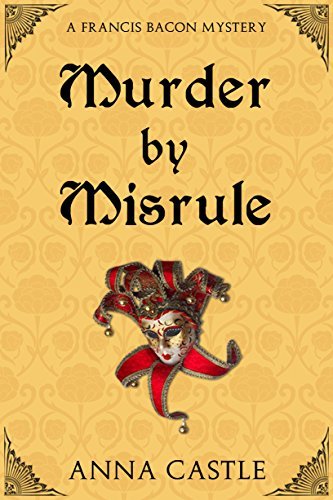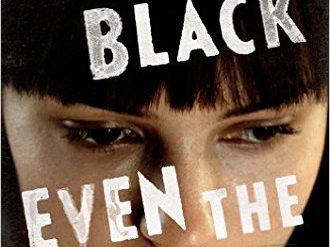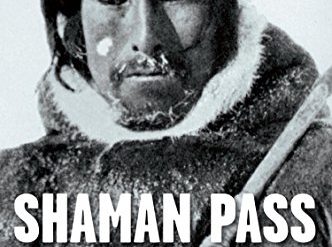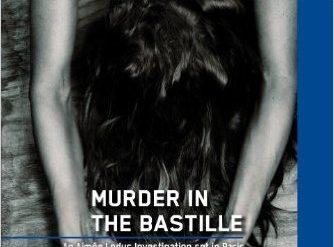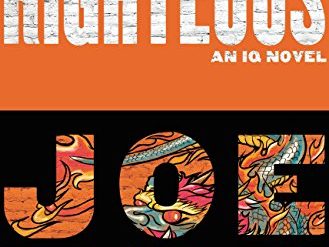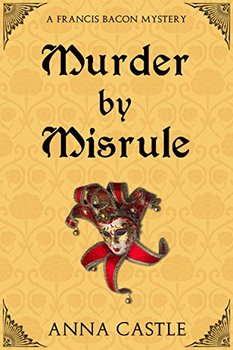
The year is 1586, the Spanish Armada two years in the future. A brilliant young English lawyer named Francis Bacon is headed for glory and high office. He was the youngest man yet to have been admitted to the bar and still is only twenty-five. Yet his impulsive nature has landed him in disrepute with the Queen, who has banished him from the Royal Court. Only when his powerful uncle assigns him to investigate the murder of a fellow barrister at Gray’s Inn does Bacon see a way back into the Queen’s good graces. Thus, with customary drive and efficiency, he enlists the law students he is tutoring and sets out on an investigation that will expose the tragic fault lines in English society. Welcome to Murder by Misrule, the first in a series of six Francis Bacon mysteries.
Murder by Misrule (Francis Bacon Mystery #1) by Anna Castle (2014) 350 pages ★★★★☆
Bacon’s uncle, Lord Burghley, the Lord Treasurer, is convinced that Tobias Smythson was murdered by another barrister at Gray’s Inn. Working with his four young students, one of them as young as fifteen, Bacon’s assignment is to prove that Smythson was killed because he had uncovered the truth behind a Catholic conspiracy to smuggle seditious literature into the country. Sometimes together, sometimes apart, Bacon and the students stumble toward a solution to the case, risking their careers and their lives in the process. The novel is an encouraging beginning for the series of Francis Bacon mysteries.
The historical record
The Elizabethan Age was a time of great tumult in England. Although the Wars of the Roses (1455-87) had settled the civil war a century earlier, the country was still in the throes of religious conflict following the reign of Henry VIII (1491-1537). Conspiracies abounded, with Queen Mary of Scots in the Tower and her followers hatching one failed plot after another to assassinate Queen Elizabeth and return England to the not-so-tender mercies of the Roman Church. And in 1588, the Spanish Armada headed for disaster on England’s shores. Yet it was also the era of the English Renaissance, the time of William Shakespeare (1564-1616), Christopher Marlowe (1564-93), and Ben Jonson (1572-1637). And, yes, this was the time of Francis Bacon, too, who was in fact an historical figure of great importance.
The father of the scientific method
In centuries to come, Francis Bacon (1561-1626) came to be widely regarded as the father of the scientific method. A lawyer as well as a philosopher and statesman, he became the first person designated as Queen’s Counsel when Elizabeth I named him as her legal advisor in 1597. Later, under James I (James VI of Scotland), he was knighted and served successively as Attorney General of England and Wales and as Lord High Chancellor. Given his eminence as a methodical thinker, it’s not far-fetched to imagine him as the protagonist of the Francis Bacon mysteries.
“A world lit only by fire”
Shakespeare’s plays may give us the impression that life in the Elizabethan Era was in many ways like our own because, well, people were people. But that’s a trap. It’s important to remember that the time of her reign was still, in the words the historian William Manchester used to describe an earlier century, “a world lit only by fire.” Practically nothing we take for granted today in our daily lives had yet been invented. Life expectancy at birth was about forty years, but if one survived to the age of thirty, they would live on average to just under sixty. And the England of her time housed fewer than four million people, whereas today the country’s population is fifty-six million. London then held some 200,000 people; today the population stands at 9.3 million. Just imagine how much different life would be with population density so much lower. Imagine, too, the impact of the infectious diseases that swept through London then in a time when doctors were clueless about its origins.
For additional reading
See my review of the second book in this series, Death by Disputation (Francis Bacon #2) by Anna Castle (Religious conflict in Elizabethan England fuels this gripping spy story).
I’ve also reviewed three other mystery novels set in the Elizabethan Age:
- A Prisoner in Malta (Christopher Marlowe #1) by Phillip DePoy (A delightful historical mystery novel starring Christopher Marlowe)
- To Shield the Queen (Ursula Blanchard #1) by Fiona Buckley (A worthy murder mystery set in the court of Queen Elizabeth I)
- The Eyes of the Queen (Agents of the Crown #1) by Oliver Clements (They’re trying to assassinate the queen!)
And check out Famous people as detectives in fact and fiction.
You might also enjoy my posts:
- Top 10 mystery and thriller series;
- 20 excellent standalone mysteries and thrillers;
- 5 top novels about private detectives; and
- Two dozen outstanding detective series from around the world.
If you’re looking for exciting historical novels, check out Top 10 historical mysteries and thrillers reviewed here (plus 100 others) and 20 most enlightening historical novels (plus dozens of runners-up).
And you can always find my most popular reviews, and the most recent ones, plus a guide to this whole site, on the Home Page.

